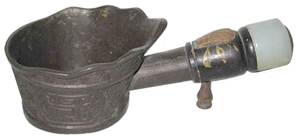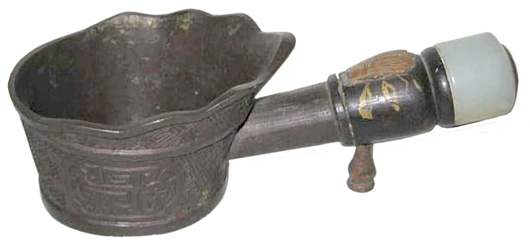
Permanent-press fabrics have relieved most households of the need to iron clothing. In past centuries, ironing was an almost daily duty of a woman in the home. Before about the 10th century, cloth was ironed with smooth wooden or glass pieces and a pounding stick. Heat was not used until the 16th century in Europe. By then, pressing irons were metal pans with long handles. A piece of charcoal was put in the pan to heat the bottom and the heated pan was rubbed over the cloth.
This crude iron was gradually improved. Charcoal was replaced by a heated iron rod to avoid the charcoal ashes that sometimes fell on the cloth. Next came special box irons with handles and pointed fronts. They were shaped like the electric and steam irons used today. Soon a solid piece of iron, also in today’s familiar shape, was made to put on the stove to heat, then quickly used to heat and smooth cloth. By the turn of the 20th century, irons were heated by liquid gas, alcohol, gasoline or electricity. Unfortunately, some of the liquid-fueled irons blew up.
The electric iron was patented in 1882, but few homes had electricity back then. So the electric iron was not in general use until about 1915. Since then, irons have been improved with the addition of thermostats that control heat and steam. Some even became cordless and could fold up to go with travelers. All types of old ironing sticks, mangling boards and irons are collected today. Nineteenth- and unusual 20th-century examples sell for hundreds of dollars.
In the 1950s, an early Chinese iron that looks like a small, ornate cooking pot with a handle was copied and used as a portable ashtray. These mid-20th-century copies sell for about $30 today. A genuine antique Chinese iron is worth hundreds of dollars.
***
Q: Recently I purchased five matching maple side chairs with “Mottville, N.Y.” stamped on the back of the top slat of each chair. Two of the chairs are stamped “F. Sinclair” under “Mottville,” while the other three are stamped “Union Chair Works.” I’ve cleaned up the chairs and given them new woven seats. Please tell me the approximate age and value of the chairs, and explain the different marks.
A: The Union Chair Works factory was built in Mottville, near Skaneateles, N.Y., in 1866, although some records say the founding of the company dates back to 1859. The company’s owners, Joseph Hubbard and Francis A. Sinclair, advertised their furniture under the brand name “Common Sense” and eventually made chairs, rockers, tables and settees. The company operated at least into the 1880s, and perhaps into the early 1900s. If all you had to do to get the chairs into tiptop shape was clean them and replace the woven seats, the set could sell for more than $500.
* * *
Q: I want to leave my collection of Hummel figurines to my 14-year-old great-granddaughter. What should I wrap them in and how should I store them?
A: Hummel figurines are based on the drawings of the nun M.I. “Berta” Hummel. They were first made in 1935 by the W. Goebel Porcelain Co. of Oeslau (now part of Rodental), Germany. The figurines are made of earthenware. Parts that aren’t glazed will absorb moisture, so they need to be stored in a dry place. Don’t store them in the basement, which often is damp, or in the attic, where they would be subject to extreme temperature changes, which could cause crazing. You can wrap the figurines in plain archival paper, white tissue paper or pieces of white bedsheets and pack them carefully in a box with bunches of tissue paper between them to prevent them from bumping each other when the box is moved. Don’t wrap them in newspaper. Newsprint comes off and may stain the figurines. Don’t wrap them in colored paper or plastic, either. The best way to store them is in their original boxes, if you still have them.
***
Q: My mother left me an oval brooch made of blue milk glass. I think it originally belonged to her grandmother, who died in 1924. It’s a series of little blue balls and tiny silver balls. The gold-tone border is impressed “Czechoslovakia” in capital letters on the back. What do you think it’s worth?
A: The country of Czechoslovakia was formed in 1918, when World War I ended. So your brooch was not made before 1918. The country split into the Czech Republic and Slovakia in 1993. Costume jewelry made of Czechoslovakian glass sells for a wide range of prices, depending on design and condition. Your brooch could sell for $20 to $50.
** *
Q: I was pleased to see your recent column about furniture designs by Charles Rohlfs. But being from Buffalo, N.Y., I was disheartened that you said Rohlfs was a New York City furniture maker. He actually lived and worked in Buffalo.
A: Thanks for speaking up for Buffalo. Rohlfs (1853-1936) was born in Brooklyn, N.Y., and studied design at the Cooper Union in Manhattan. But he moved his family to Buffalo in 1887, when he took a job with a stove manufacturer there. In 1897 he opened his own workshop in Buffalo and created his unique furniture designs for a decade.
** *
Tip: If you get gum on your Oriental rug or carpet, freeze it with an ice cube in a plastic bag, then scrape it off with a plastic credit card.
***
Sign up for our weekly email, “Kovels Komments.” It includes the latest news, tips and collector’s questions and is free if you register on our website. Kovels.com provides lists of publications, clubs, appraisers, auction houses, people who sell parts or repair antiques and more. Kovels.com adds to the information in this column and helps you find useful sources needed by collectors.
***
Terry Kovel answers as many questions as possible through the column. By sending a letter with a question, you give full permission for use in the column or any other Kovel forum. Names, addresses or email addresses will not be published. We cannot guarantee the return of any photograph, but if a stamped envelope is included, we will try. The volume of mail makes personal answers or appraisals impossible. Write to Kovels, (Name of this newspaper), King Features Syndicate, 300 W. 57th St., New York, NY 10019.
* * *
CURRENT PRICES
Current prices are recorded from antiques shows, flea markets, sales and auctions throughout the United States. Prices vary in different locations because of local economic conditions.
Madame Alexander doll, Chatterbox, hard plastic and vinyl, pigtails, sleep eyes, head turns, talk button in front, battery-operated, 1961, 24 inches, $55.
Bermuda Triangle board game, made in Ireland, Milton Bradley, 1976, 20 x 12 inches, $60.
Cookie pail, Sunshine Biscuits of New York, red, white and blue cardboard, pictures little cookies in toy shapes, tin cover, handle, 1950s, 11 ounces, $70.
Cambridge Glass cake stand, Virginia pattern, rum well in center, 1940s, 8 x 11 inches, $200.
Cameo pin, diamond accent around woman’s neck, carved flowers at left shoulder, dress draped across front, silver filigree and scrollwork, 1920s, 1 5/8 x 1 1/2 inches, $275.
Bellows, turtleback, painted long-tailed bird, black ground, brass nozzle, American, 19th century, 17 3/4 inches, $555.
Show towel, silk and wool on linen, potted flowers, peacocks and trees, 2 verses, 3 rows of fringe, “Catherine Derr,” 1854, 60 x 17 3/4 inches, $705.
Hepplewhite card table, mahogany, poplar and chestnut, shaped top over banded inlay panels, tapered legs with string inlay, 1800-1815, 30 x 35 x 18 inches, $1,765.
Newcomb College pottery jar, lid, blue matte glaze, raised flowers, vines and leaves, marked, Anna Francis Simpson, 1919, 7 inches, $4,720.
Chippendale tall case clock, mahogany and pine, broken-arch pediment, floral rosettes, glass door, 8-day movement, signed John Fissler, Frederick Town (Md.), c. 1790, 102 1/2 inches, $4,995.
***
Keep up with changes in the collectibles world. Send for a FREE sample issue of our 12-page, full-color newsletter, “Kovels on Antiques and Collectibles,” filled with prices, news, information and photos, plus major news about the world of collecting. To subscribe at a bargain $27 for 12 issues, write Kovels, P.O. Box 8534, Big Sandy, TX 75755; call 800-829-9158; or subscribe online at Kovelsonlinestore.com.
***
© 2012 by Cowles Syndicate Inc.
ADDITIONAL IMAGE OF NOTE



